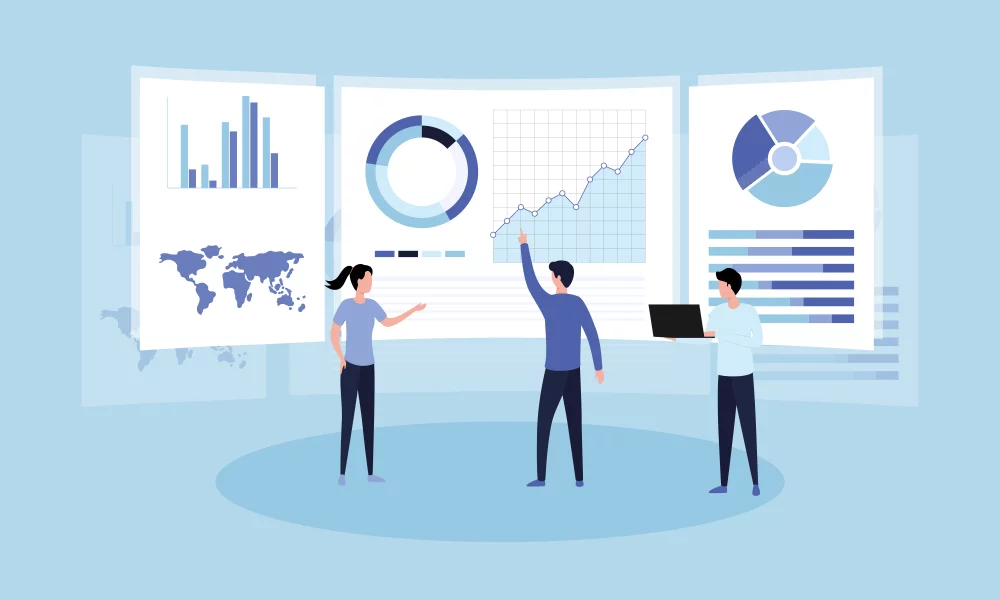
Introduction
- Data Science is the field of study that includes extracting critical information from large quantities of data. It is done through algorithms, process and various scientific methods.
- Important Data Science job roles include data scientist, data engineer, statistician, business analyst, data analyst, etc.
- It is extensible used by gaming world, banking sectors, health industry and e-commerce sites.
- World-renowned companies like Netflix and Proctor and Gamble use Data Science to get the desired outcomes.
- It is one of the most highly demanded fields presently.
Data Science has improved considerably over the last two years. Nearly 90% of the available data was generated in the previous two years, proving that data scientists have increased tenfold. It is now widely used by big corporate companies and industries across the globe. The data science sector has been flourishing at a much faster pace than other areas.
Do you want to step into the world of data science and gain all the fame associated with it? You are in the right place then! This article will broadly explore the methods, tools and process involved in data science. It will also provide with an in-depth insight into the world of data science and what it takes to become a data scientist. The article will also cover various aspects of this field and how it is extensively used by renowned companies worldwide. Let’s immerse ourselves in the world of the most exponentially growing area of study!
What is Data Science?
It is one of the most common questions that one has in mind while searching for Data Science.
- Data Science is an interdisciplinary field that derives knowledge and simplified information from structured and unstructured data. This simplified information makes it easy to read and retain it.
- Data Science exclusively refers to the process of assigning meaning to a group of data.
- Data Scientists use cloud computing tools to create an environment for virtual development. Mathematical Statistics, Big Data and Machine Learning, are some standard methods used in the process.
- Large Scale businesses use Data Science strategies in creative ways. It also increases their competitive advantage in the world of business.
- Data Science processes include Business Analytics, Business Intelligence, Data Mining, Predictive Analytics, Data Analytics and Data Visualisation.
Why is Data Science becoming so popular?
- Data Science helps in transforming a problem into research. It similarly comes up with a practical solution.
- You can identify fraudulent activities with the help of Data Science. It saves your business from falling into fake and virtual traps.
- You can increase your customer brand loyalty. Data Science makes that possible as it performs sentiment analysis. It also helps you to recommend the exact product that your customer demands.
- It prevents any kind of monetary loss.
- It boosts the process of decision making, and it makes it quicker and faster.
- One of the coolest features of data science is that it lets you develop your machines’ intelligence ability!
Is Data Science similar to Business Intelligence (BI)?
Although they are often interchangeably used, they are not similar!
- Data Science is a vast field that makes use of Business Intelligence as one of its strategies. Hence, BI falls under the parent category of Data Science.
- BI focuses on visualisation and statistics, and Data Science focuses on statistics, Graph and Machine Learning.
- BI uses tools like Microsoft Bl, Pentaho and QlikView. Data Science uses tools like TensorFlow and R.
- Business Intelligence analyses the history, experiences and related data. Data Science uses these to analyse and predict what lies in the future. Where BI identifies the problem, Data Science provides a solution to it through Neuro-linguistic programming and analysis.
What are the components of Data Science?
- Statistics: It is the most important unit. Statistics refers to the scientific method of collecting and analysing vast quantities of numerical data. It provides useful insights.
- Visualization: It helps in accessing a large amount of data through digestible and straightforward visuals. It makes data easy to decipher.
- Machine Learning: It accentuates the study of algorithms. It also helps in building the same. It is done in order to make predictions about future data.
- Deep Learning: It is a comparatively new research field of machine learning. Here, the algorithm particularly chooses the analysis model that will be followed.
What are the tools used by Data Science?
- Data Sets: Data is acquired from a lot of researches which were conducted in the past. The data is then analysed through analytical tools and algorithms. Without Data Sets, Data Science research is impossible as there will be no data to analyse.
- Big Data: It is the collection of a very complicated and massive amount of data. It is difficult to process using traditional data processing applications or on-hand database management tool. Traditional software, at no cost, can manage Big Data. Hence, Data Scientists came up with another device.
- Hadoop: Hadoop was initially developed to handle Big Data that no traditional software could manage. It stores and processes these large datasets. HDFS or Hadoop Distributed File System manages the storage in Hadoop. It further improves the availability of data by distributing them evenly across the ecosystem. It first breaks the information into segments and then spreads them to various nodes in a cluster.
MapReduce is the most crucial element of Hadoop. The algorithms function by mapping and reducing data. The mappers break the more significant tasks into smaller ones. These smaller tasks are distributed evenly. Once the mapping is done, the results are aggregated. The effects are reduced to comparatively more uncomplicated values through the Reduce process.
- R Studio: It is an open-source programming language and software environment. It deals with graphics and statistical computing under the R Foundation. It can also be used for analytical purposes as a programming language. It can be used for Data Visualisation. It is simple and easy to read, write and learn. Since it is an open-source, people can distribute its copies, read and modify its source code, etc. R studio, however, cannot manage Big Data.
- Spark R: Using Hadoop, processing input with R Studio is quite tricky since it cannot function in a distributed ecosystem. Hence, we use Spark R. Spark R is an R Package. It provides a simple way of using R with Apache Spark. It provides distributed data frames. These data frames can be implemented to filter, select and aggregate large data sets.
What are the processes used in Data Science?
- Exploring Data: It generally deals with collecting data from the external as well as internal sources. It is done to answer or provide a solution to a particular business question. The data that it deals with is collected through streaming from online sources using APIs, from census datasets, social media and as logs from web servers.
- Preparation of Data: It cleans inconsistencies like blank columns, missing value and incorrect data format. Before modelling, the data needs to be explored, processed and conditioned. With clean data, you can achieve better prediction.
- Model Planning: You need to identify the technique and method to draw a relation between input variables. Model planning is done by using various statistical formulae and visualisation tools. R, SQL analysis services are some of the tools used for model planning.
- The building of Model: Data sets are evenly distributed for testing and training. Techniques of clustering, classification and association are applied to training data sets. When the model is prepared, it is tested against the testing dataset.
- Operationalization: Final model is delivered with technical documents, reports and codes. The model is thoroughly tested. If it passes the test, it is used as a real-time production environment.
- Results: The results are communicated to all the stakeholders. It genuinely decides if the results are successful and or not. The decision is made based on the inputs from the model.
Which job are roles associated with Data Science?
- Data Scientist: A data scientist handles large quantities of data to produce compelling visions for the particular business. They make use of various algorithms, tools, methods and processes. A Data Scientist deals with programming languages like R, Python, SAS, SQL, Matlab, Spark, Hive and Pig.
- Data Analyst: They mine vast quantities of data. They look for trends, patterns and relationships in data. They do so to deliver compelling visualisation and reporting. These are further used to analyse data. Business decisions are made only after this. They deal with programming languages like R, Python, SQL, C++, C, HTML, and JS.
- Data Engineer: A Data Engineer works with large quantities of data. They maintain, build, develop and test architectures such as large scale databases and processing systems. They deal with programming languages like Java, C++, R, Python, Hive, SQL, SAS, Perl and Ruby.
- Statistician: They use statistical methods and theories to collect and analyse data. They also use these to understand quantitative as well as qualitative data. They deal with programming languages like Spark, Perl, R, SQL, Python, Tableau and Hive.
- Business Analyst: They are responsible for improving business processes. They act as the bridge between the IT department and the business executive. They deal with programming languages like SQL, Python, Tableau and Power BI.
- Data Administrator: They ensure the accessibility of the database to all the users. They look after its correct and safe performance to prevent it from getting hacked. They deal with programming languages like SQL, Java, Ruby on Rails, Python and C#.
What are the applications of Data Science?
- Google Search: It uses Data Science to search for a particular result within a few microseconds.
- Speech and Image Recognition: Speech deals with many systems like Siri, Alexa and Google Assistant. All of this has been possible due to the application of Data Science. An example of image recognition is when you upload a photo with your friend in social media, it recognises your friend and shows suggestion tags.
- Recommendation System: Data Science is used in creating a recommendation system. Suggested friends in social media, suggested videos on YouTube and suggested purchase on e-commerce sites are examples.
- Price Comparison: Shopzilla, Junglee and PriceRunner make use of Data Science. Using APIs, data is fetched from particular websites.
- Games: Nintendo, Sony and EA Sports use Data Science. Machine learning technique is used to develop games. When you move to higher and more complicated levels, it updates itself to face more complications henceforth. You also get to unlock various prizes. All of it has been possible due to Data Science.
Which sectors use Data Science?
- E-Commerce: Online retailers make use of Data Science in 4 ways. It is done to achieve business value. The four methods include identifying the target customers, exploring the potential customers, increasing sales with product recommendations and extracting useful feedback from reviews.
- Manufacturing Industry: It uses Data Science in 8 ways to analyse its productivity, minimize risks, and increase profit. These eight ways include tracking performance and defects, predictive maintenance, forecasting demand, supply chain relations, global market pricing, automation, new product development techniques, and increased efficiency of sustainability.
- Banking: Banking sectors use Data Science in fraud detection, risk modelling, customer value, customer segmentation and real-time predictive analysis.
- Healthcare Industry: It uses Data Science for patient prediction and patient tracking. It also uses it for electronic health records, significant data imaging and predictive analytics.
- Transport: Transport sectors use Data Science go to ensure a safer driving environment for drivers. It optimizes vehicle performance. It also adds autonomy to the drivers. Data Science has also given rise to self-driving cars.
Which well-known organisations make use of Data Science?
- Netflix: Yes, you read that right. It uses Data Science to understand what accentuates the interests of the users. Depending on the information collected, it premiers the next production series.
- Proctor and Gamble: It uses Data Science’s time series models. Through these models, it understands the future demands and plans for production levels accordingly.
- Target: It uses Data Science to identify the major customer segments and their shopping behaviour. Through this, they guide different audiences.
How to Become a Data Scientist?
- Educational Qualifications: You should have a bachelor’s degree in any of these fields — Computer Science, Physics, Social Science and Statistics. The most common areas include Statistics and Mathematics, followed by Computer Science and Engineering.
- Learn Statistics and Mathematics: An individual needs to have a stable ground of Mathematics and a basic understanding of Statistics in order to become a Data Scientist. You must be familiar with causation, correlation and hypothesis testing. Linear algebra and calculus are essential.
- Practice Programming: You must be familiar with the programming language of Python. Database interaction is equally important. If you develop a good knowledge of Python, move forward to learning other programming languages like Java and R.
- Focus on Machine Learning: It is advisable to learn the standard algorithms which are also popular. Learning complicated problems do not always help. Start with the simpler ones what matters us your problem solving and optimization capacities.
- Create Machine Learning Projects: Start implementing the knowledge that you have developed on machine learning. Big firms always look for the ones who know how it works behind the screen.
- Keep up with the trend: Upskilling is very important. Presently, companies are looking for people who are skilled in Robotics, Cybersecurity, RPA, Artificial Intelligence, Automation, Data Analytics and FinTech.
- Create a Portfolio: Your resume must mention your coding and software skills. Candidate username, e-mail address, locations and current employers must be specified. What enhances your portfolio is a large number of followers, improving on stars, contribution graph, writing targeted code, contribution graph and so on.
What are the challenges faced by Data Science?
- High-quality data is necessary for accurate analysis.
- A small organisation cannot have a Data Science department.
- Adequate Data Scientists are not available even though it is a highly demanded field.
- There might be privacy issues.
- A company’s management fails to provide the financial support needed to build a Data Science team.
- It is challenging to explain Data Science to people who do not possess any knowledge in this field.
- Access to data is either unavailable or difficult.
- Business decision-makers fail to use Data Science results effectively.
Conclusion
There are plenty of career opportunities if you are dealing with Data Science. Multi-national companies are always filtering data and optimizing it for better customer experience. Essential sectors like banks, healthcare industries, transportation, e-commerce sites use Data Science to get the best results. The world is continuously upgrading itself into a better version. It generally paves the way for data science necessities in dealing with humongous amounts of data and satisfying the customers!
In the coming years, the world will need more than 140,000 data scientists. It has been reported that the income of data scientists in the US is about $144,000 per year. Hence, it is high time people should consider Data Science as a compelling career choice. The companies should also invest in it and provide the financial support that it needs.
With all the information at hand, you are hopefully prepared to become a successful Data Scientist in the future. Hope this helps and all the best for your future endeavours!




